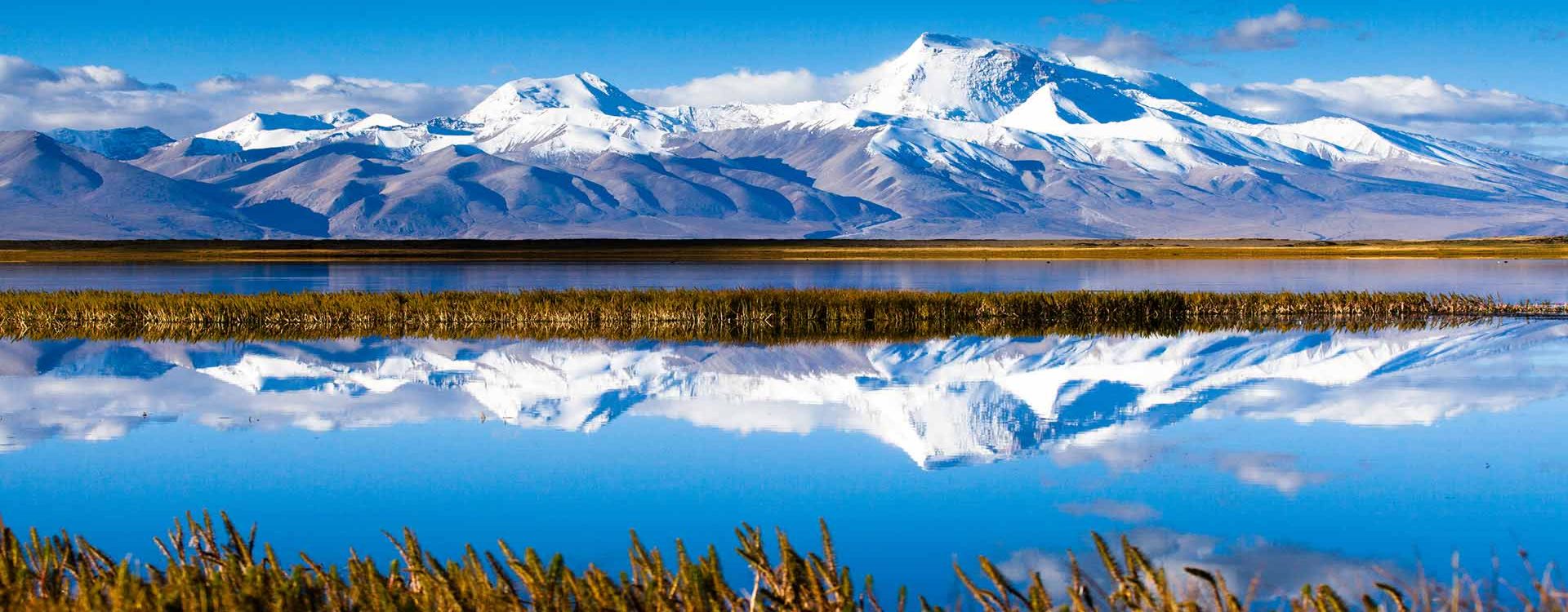

Breathtaking vistas and spectacular landmarks are the heart and soul of Nepal's magnificent landscape, and there isn't a better way to experience its cultural and natural treasures than a tour of Kailash Yatra and Manasarovar Yatra. Beginning in the wondrous streets of Kathmandu, the tour winds through the legendary Rivers of the Lion, Horse, Peacock and Elephant before they greet the Hindu vision of Mount Meru and the Tibetan Khang Rimpoche (Precious Jewel of the Snow), the spiritual center of the universe, at a dramatic 6,740 meters on the Himalayan border. Encompassing the soul of Tibetan Buddhism, Hinduism, Jainism and Bonpo, it is a region in which life, spirituality, and essence all converge as do the four rivers from the Mountain's pristine lake.
With its roots descending into the depths of the earth and its peaks rising into the endless sky, the “world pillar” is the home of Shiva and his consort Parvati, and where the first prophet of the Jains experienced enlightenment – making it a sight unlike any other on the planet. Whether seeking spiritual fulfillment, fascinated by history and religion, marveling at nature's wonders or all of the above, the journey to Mount Kailash is one which will enthrall trekkers from virtually every walk of life with its stunning views and incomparable atmosphere – the place from which life force flows.
This life-changing destination is a tour you won't forget.
You will be met and welcomed at the airport by one of our office Representative, with a garland of flowers, and transferred to hotel. In the evening, our guide will brief you about your tour. Please get ready with your passport to handover to us for visa preparation at Chinese embassy the following day. Overnight at hotel, inclusive of breakfast.
Today you will join a half day tour of Kathmandu with English speaking tour. Late afternoon, you can go to trekking equipment shop to buy trek gears if any. We will arrange Chinese visa today itself and handover your passport and visa in the late evening. Overnight at hotel, inclusive of breakfast.
You will drive to Kodari, the friendship bridge, and then to Nyalam (3750 meters). Total distance: 125 km Approximate driving: 5 hrs. Overnight at Guesthouse, inclusive of breakfast.
Nyalam is situated at 3750 meters above the sea level, which is quite high; so you will spend 2 nights here with an excursion to Milarepa's Cave. Overnight at same Guesthouse, inclusive of breakfast.
Today you will enjoy impressive view of landscapes while driving to Saga - 4450 meters via Lulling La Pass (5050 meters), Paiku Tso lake and cross the Brahmaputra river (known here as the Yarlung Tsangpo). The total distance is 250 km and approximate driving is abut 5 - 6 hrs. Overnight Guesthouse, inclusive of breakfast.
Today you will drive to Paryang with smooth drive, which is 250 km that takes approximately 5 - 6 hours. Overnight Guesthouse, inclusive of breakfast.
Today you will drive to Mansarovar lake, the pristine lake in the high mountain range. Total driving distance is about 280 km and approximately 5 - 6 hours driving. Overnight Guesthouse, inclusive of breakfast.
In the morning you will take a holy bath in Mansarovar lake, and do a Parikrama by jeep and also visit to Chiu Gompa before proceeding to Darchen (4570 meters). Overnight at Guesthouse, inclusive of breakfast.
Today you will spend the night at Drira-Puk (4765m), the vantage point to observe the Mt. Kailash. Overnight at Guesthouse, inclusive of breakfast.
Today you will continue the Parikarma and trek over Dolma La (5610 meters) and you will trek down to Zutul-Puk (4700 meters), overlooking down to Gauri Kund (lake). Overnight at Guesthouse, inclusive of breakfast.
You will trek down near Darchen, where you will meet your jeep and driver waiting, and drive to Hore (Hor Qu) at 4560m near Lake Manasarovar. Overnight at Guesthouse, inclusive of breakfast.
On the way back, we drive quicker and arrive in Nyalam. Overnight at Guesthouse, inclusive of breakfast.
Drive to boarder; check out from Chinese immigration, and you will continue drive to Kathmandu.
Drive to Airport or extend your trip to Nepal. Tour ends.
Want to make your own customized trip ? Click Here
| Trip Start Date | Trip End Date | Availability | Book | ||||
|---|---|---|---|---|---|---|---|
|
Sunday
19-May, 2024 |
Saturday 01-Jun, 2024 |
Guaranteed | Join Now | ||||
|
Friday
07-Jun, 2024 |
Thursday 20-Jun, 2024 |
Guaranteed | Join Now | ||||
|
Monday
17-Jun, 2024 |
Sunday 30-Jun, 2024 |
Guaranteed | Join Now | ||||
|
Tuesday
18-Jun, 2024 |
Monday 01-Jul, 2024 |
Guaranteed | Join Now | ||||
|
Thursday
08-Aug, 2024 |
Wednesday 21-Aug, 2024 |
Guaranteed | Join Now | ||||
|
Thursday
15-Aug, 2024 |
Wednesday 28-Aug, 2024 |
Guaranteed | Join Now | ||||
|
Friday
13-Sep, 2024 |
Thursday 26-Sep, 2024 |
Guaranteed | Join Now | ||||
|
Friday
20-Sep, 2024 |
Thursday 03-Oct, 2024 |
Guaranteed | Join Now | ||||
|
Wednesday
12-Jun, 2024 |
Tuesday 25-Jun, 2024 |
Guaranteed | Join Now | ||||
|
Friday
14-Jun, 2024 |
Thursday 27-Jun, 2024 |
Guaranteed | Join Now | ||||
|
Sunday
04-Aug, 2024 |
Saturday 17-Aug, 2024 |
Guaranteed | Join Now | ||||
|
Sunday
11-Aug, 2024 |
Saturday 24-Aug, 2024 |
Guaranteed | Join Now | ||||
|
Monday
09-Sep, 2024 |
Sunday 22-Sep, 2024 |
Guaranteed | Join Now | ||||
|
Monday
16-Sep, 2024 |
Sunday 29-Sep, 2024 |
Guaranteed | Join Now | ||||